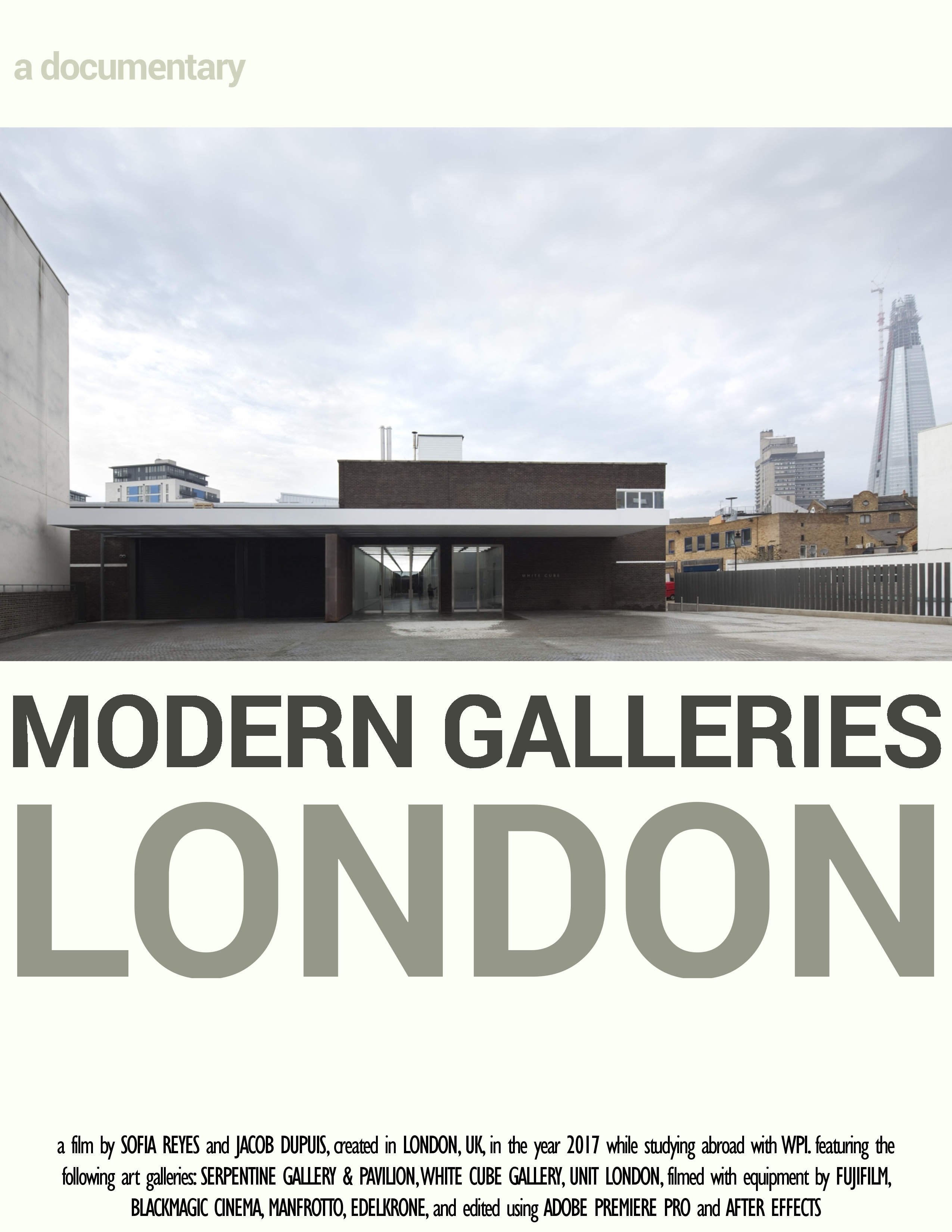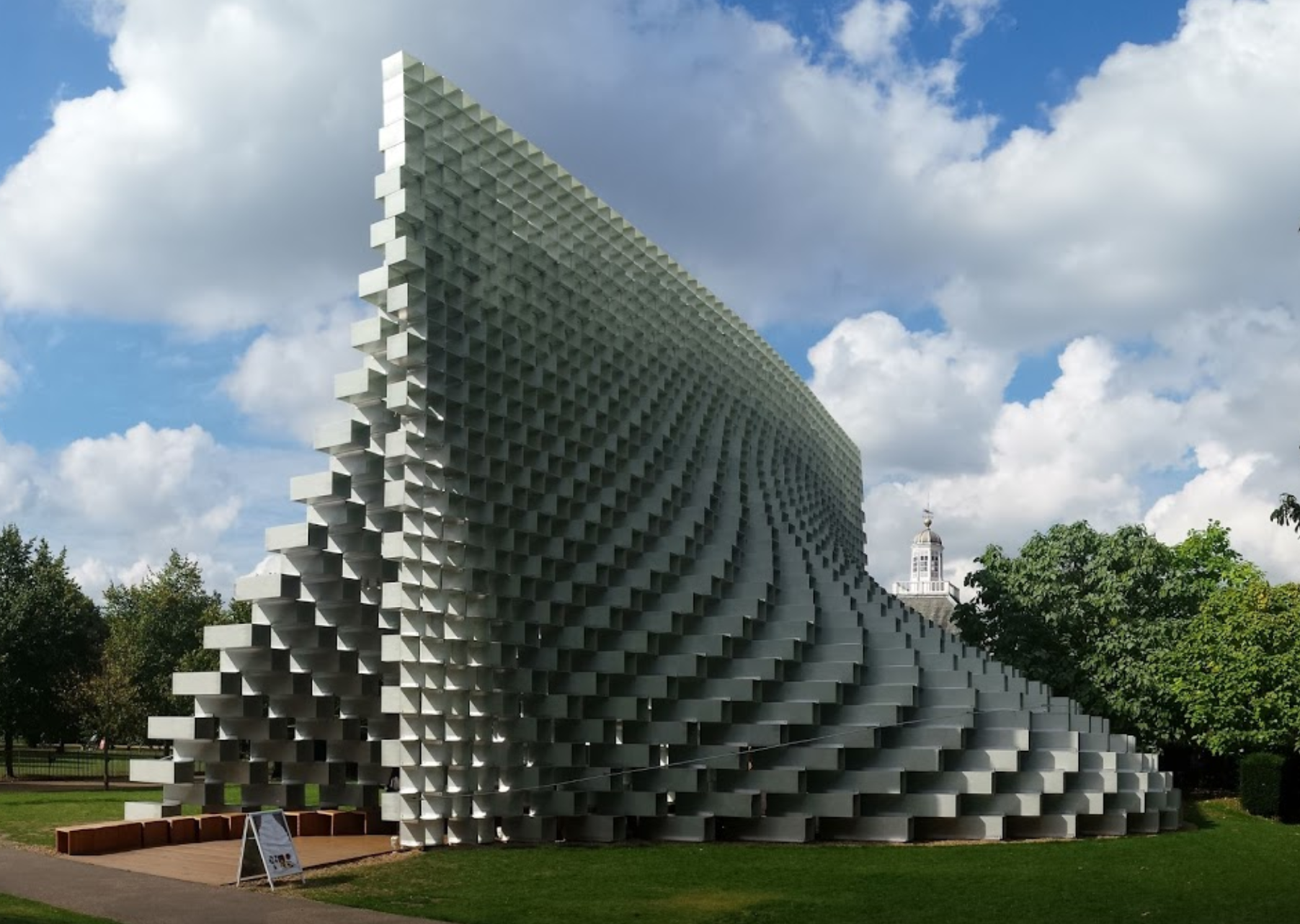Difference between revisions of "Modern Galleries in London: a Documentary"
From Londonhua WIKI
| Line 24: | Line 24: | ||
<br> | <br> | ||
==History of Documentary== | ==History of Documentary== | ||
| − | [[File:BookD.PNG|x450px|alt=Sofia Reyes]] | + | {{Infobox |
| + | |title = Introduction Documentary | ||
| + | |bodystyle = width:25em | ||
| + | |image = [[File:BookD.PNG|x450px|alt=Sofia Reyes]] | ||
| + | |caption = Book to provide concepts that characterize documentary film. | ||
| + | }} | ||
The documentary film can be regarded as the first genre of the cinema. During the 1890s, when the cinema came into existence, most viewers saw some kind of actuality' film. These early documentaries were often simple, single-shot affairs, showing newsworthy events, scenes from foreign lands, or everyday events. However, more fictional (or staged) actualities also began to be produced from the earliest years of the cinema, based on the special effects capacity of the cinema. An example here might be the Lumiere brothers' Arroseur arrose, which appeared as early as 1895, but per- haps the most well known is Georges Melies' Trip to the Moon (1902) Between 1895 and 1905 a number of identifiable genres of documentary film emerged, including topicals 'travelogues scenics', industrials sports films trick' films fantsy' films, and films that used fictional recon struction or staging in a variety of ways. These early genres of documentary film were quickly assimilated into existing modes of popular culture and entertainment and initially appeared in venues that used other, non-filmic, forms of performance such as acrobatics, song, and dance. <ref> Aitken, I. (2006). Encyclopedia of the documentary film. New York: Routledge.</ref> | The documentary film can be regarded as the first genre of the cinema. During the 1890s, when the cinema came into existence, most viewers saw some kind of actuality' film. These early documentaries were often simple, single-shot affairs, showing newsworthy events, scenes from foreign lands, or everyday events. However, more fictional (or staged) actualities also began to be produced from the earliest years of the cinema, based on the special effects capacity of the cinema. An example here might be the Lumiere brothers' Arroseur arrose, which appeared as early as 1895, but per- haps the most well known is Georges Melies' Trip to the Moon (1902) Between 1895 and 1905 a number of identifiable genres of documentary film emerged, including topicals 'travelogues scenics', industrials sports films trick' films fantsy' films, and films that used fictional recon struction or staging in a variety of ways. These early genres of documentary film were quickly assimilated into existing modes of popular culture and entertainment and initially appeared in venues that used other, non-filmic, forms of performance such as acrobatics, song, and dance. <ref> Aitken, I. (2006). Encyclopedia of the documentary film. New York: Routledge.</ref> | ||
Since the early 1900s, filmmakers have been capturing and telling the stories of real people, places, and events along side fictional ones. The desire to learn or experience something new through film was growing. In 1926, John Grierson, a Scottish filmmaker and expert, created the term Documentary, when reviewing the film ''Moana'', by American filmmaker Robert Flaherty.<ref>(2014). "Chronology of Documentary History." California: UC Berkeley Media Resource Center.</ref> John Grierson was inspired by the works of Flaherty, and went on to create his own films in Scotland and Britain. He inevitably became in charge of the British Empire Marketing Board where he would oversee production of thousands of films produced in the United Kingdom. In 1929 he developed his own film ''Drifters'', which would then be credited as the first British documentary, introducing the storytelling medium to the English.<ref>(2011). "Making History: Exhibition Guide, Section 1, Films: Defining Documentary" London, Tate Liverpool.</ref> | Since the early 1900s, filmmakers have been capturing and telling the stories of real people, places, and events along side fictional ones. The desire to learn or experience something new through film was growing. In 1926, John Grierson, a Scottish filmmaker and expert, created the term Documentary, when reviewing the film ''Moana'', by American filmmaker Robert Flaherty.<ref>(2014). "Chronology of Documentary History." California: UC Berkeley Media Resource Center.</ref> John Grierson was inspired by the works of Flaherty, and went on to create his own films in Scotland and Britain. He inevitably became in charge of the British Empire Marketing Board where he would oversee production of thousands of films produced in the United Kingdom. In 1929 he developed his own film ''Drifters'', which would then be credited as the first British documentary, introducing the storytelling medium to the English.<ref>(2011). "Making History: Exhibition Guide, Section 1, Films: Defining Documentary" London, Tate Liverpool.</ref> | ||
Revision as of 13:17, 19 June 2017
Modern Galleries London
by Sofia Reyes and Jacob Dupuis
|
A Documentary |
Abstract
Originally we set out to create individual projects that had overlapped: Jacob set out to create a documentary on the Serpentine Pavilion, while Sofia was looking at modern art in galleries, including Serpentine. Once we combined our project into a documentary about several galleries, we decided to focus our background on the history of documentary, using the vast resources available on cinema here in London. The background of the project outlines types of documentary films, with historical examples, and the process involved in making a documentary film come to be. For our creative piece, we shot and edited a short documentary using several of these styles, that showcases modern art galleries across the city of London.
Contents
- 1 Modern Galleries London
- 2 Abstract
- 3 Introduction
- 4 Section 1: Background
- 5 Section 2: Deliverable
- 6 Conclusion & Final Video
- 7 Attribution of Work
- 8 External Links
- 9 Image Gallery
- 10 References
Introduction
I suggest you save this section for last. Describe the essence of this project. Cover what the project is and who cares in the first two sentences. Then cover what others have done like it, how your project is different. Discuss the extent to which your strategy for completing this project was new to you, or an extension of previous HUA experiences.
Section 1: Background
History of Documentary
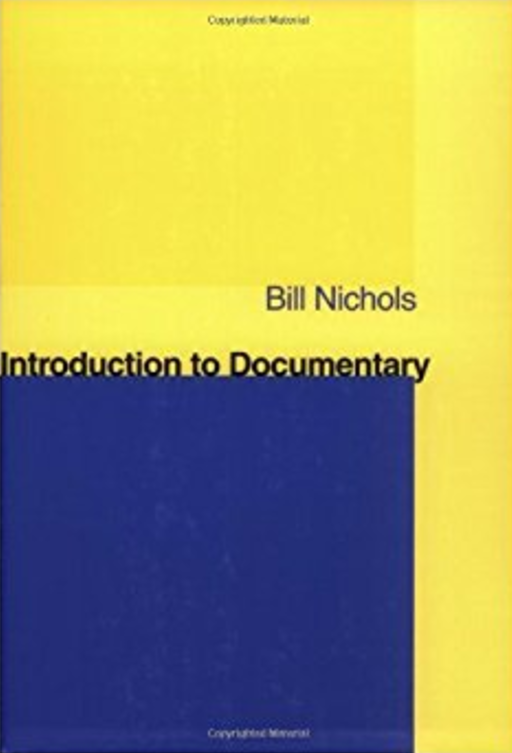 Book to provide concepts that characterize documentary film. |
The documentary film can be regarded as the first genre of the cinema. During the 1890s, when the cinema came into existence, most viewers saw some kind of actuality' film. These early documentaries were often simple, single-shot affairs, showing newsworthy events, scenes from foreign lands, or everyday events. However, more fictional (or staged) actualities also began to be produced from the earliest years of the cinema, based on the special effects capacity of the cinema. An example here might be the Lumiere brothers' Arroseur arrose, which appeared as early as 1895, but per- haps the most well known is Georges Melies' Trip to the Moon (1902) Between 1895 and 1905 a number of identifiable genres of documentary film emerged, including topicals 'travelogues scenics', industrials sports films trick' films fantsy' films, and films that used fictional recon struction or staging in a variety of ways. These early genres of documentary film were quickly assimilated into existing modes of popular culture and entertainment and initially appeared in venues that used other, non-filmic, forms of performance such as acrobatics, song, and dance. [1]
Since the early 1900s, filmmakers have been capturing and telling the stories of real people, places, and events along side fictional ones. The desire to learn or experience something new through film was growing. In 1926, John Grierson, a Scottish filmmaker and expert, created the term Documentary, when reviewing the film Moana, by American filmmaker Robert Flaherty.[2] John Grierson was inspired by the works of Flaherty, and went on to create his own films in Scotland and Britain. He inevitably became in charge of the British Empire Marketing Board where he would oversee production of thousands of films produced in the United Kingdom. In 1929 he developed his own film Drifters, which would then be credited as the first British documentary, introducing the storytelling medium to the English.[3]
While documentary film is a popular informative method of filmmaking, often the difficulty and work put in to create these films is overlooked by the audience. With the rise of smaller, high quality cameras, and better editing capabilities, documentary is becoming even more widespread than ever and still is a popular field for award-winning productions to develop.
Types of Documentary
Every documentary has its own distinct voice. Like every speaking voice, every cinematic voice has a style or “grain” all its own that acts like a signature or fingerprint. It attests to the individuality of the filmmaker or director or, sometimes, to the determining power of a sponsor or controlling organization. Individual voices lend themselves to an auteur theory of cinema, while shared voices lend themselves to a genre theory of cinema. Genre study considers the qualities that characterize various groupings of filmmakersand films.
Based on the academic work of Dr Bill Nichols, they are basic ways of organizing documentary film and video, we can identify six modes of representation
that function something like sub-genres (also called modes) of the documentary film genre itself: poetic, expository, participatory, observational, reflexive, performative.
Modes progress chronologically with the order of their appearance in practice, documentary film often returns to themes and devices from previous modes. Therefore, it is inaccurate to think of modes as historical punctuation marks in an evolution towards an ultimate accepted documentary style.
Modes are not mutually exclusive - there is often significant overlapping between modalities within
individual documentary features and it is therefore difficult to find examples that adhere only to one
mode.
These six modes establish a loose framework of affiliation within which
individuals may work; they set up conventions that a given film may adopt;
and they provide specific expectations viewers anticipate having fulfilled.
[4]
To some extent, each mode of documentary representation arises in
part through a growing sense of dissatisfaction among filmmakers with a
previous mode. In this sense the modes do convey some sense of a documentary
history.The observational mode of representation arose, in part,
from the availability of mobile 16mm cameras and magnetic tape recorders
in the 1960s. Poetic documentary suddenly seemed too abstract and expository
documentary too didactic when it now proved possible to film everyday
events with minimal staging or intervention.
Poetic Documentary
Subjective and Arttistic Expression
Poetic Mode emphasizes visual associations, tonal or rhythmic qualities,descriptive passages, and formal organization. This mode bears a close proximity to experimental, personal, or avant-garde filmmaking. This is a documentary that becomes personal to the people involved which are usually the presenter and interviewees.
Poetic documentary can be compared with the Modernist Avant-garde. This type of documentary sacrifices the conventions of continuity editing and the sense of a very specific location in time and place that follows from it to explore associations and patterns. It emphasizes some aspects of the protagonist of the film. Protagonists vary from people to places. It presents these aspects via music, different angles and the editing. Music is key because it develops the mood and tone of the story being told.
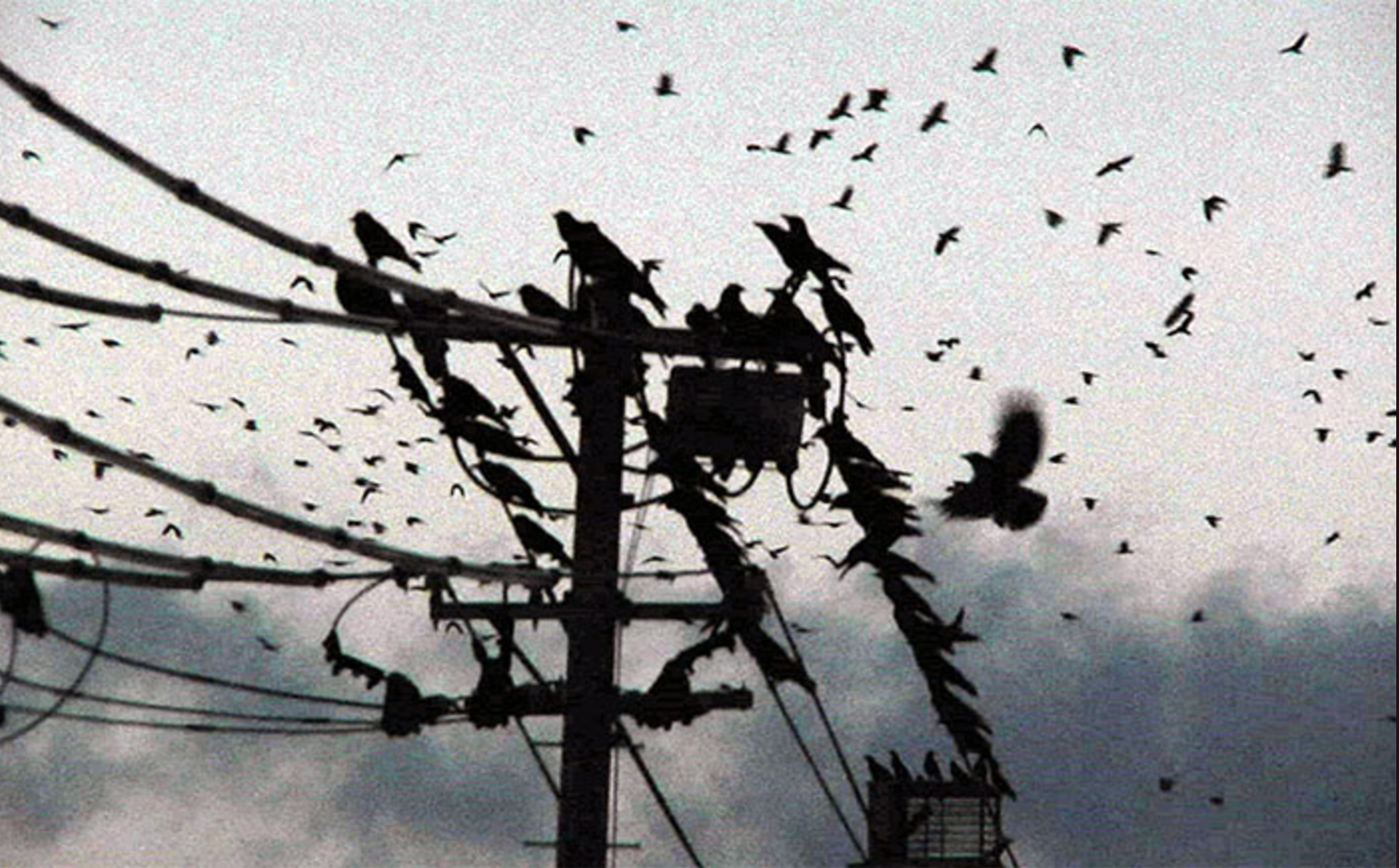 |
The poetic mode is particularly adept at opening up the possibility of alternative forms of knowledge to the straightforward transfer of information, the prosecution of a particular argument or point of view, or the presentation of reasoned propositions about problems in need of solution.This mode stresses mood, tone, and affect much more than displays of knowledge or acts of persuasion. The rhetorical element remains underdeveloped.
The editing stresses rhythm and form more than it details the actual workings of a locomotive. The documentary dimension to the poetic mode of representation stems largely from the degree to which modernist films rely on the historical world for their source material. Some avant-garde films such as Oscar Fischinger’s Composition in Blue (1935) use abstract patterns of form or color or animated figures and have minimal relation to a documentary tradition of representing the historical world rather than a world of the artist’s
imagining. Poetic documentaries, though, draw on the historical world for their raw material but transform this material in distinctive ways. Francis
Thompson’s N.Y., N.Y. (1957), for example, uses shots of New York City that provide evidence of how New York looked in the mid-1950s but gives
greater priority to how these shots can be selected and arranged to produce a poetic impression of the city as a mass of volume, color, and movement.Thompson’s
film continues the tradition of the city symphony film and affirms the poetic potential of documentary to see the historical world anew. [5]
Origin
The poetic mode began in tandem with modernism as a way of representing reality in terms of a series of fragments, subjective impressions, incoherent
acts, and loose associations.These qualities were often attributed to the transformations of industrialization generally and the effects of World
War I in particular. The modernist event no longer seemed to make sense in traditional narrative, realist terms. Breaking up time and space into multiple
perspectives, denying coherence to personalities vulnerable to eruptions from the unconscious, and refusing to provide solutions to insurmountable
problems had the sense of an honesty about it even as it created works of art that were puzzling or ambiguous in their effect. Although some
films explored more classical conceptions of the poetic as a source of order, wholeness, and unity, this stress on fragmentation and ambiguity remains
a prominent feature in many poetic documentaries.
The historical footage, freeze frames, slow motion, tinted images, selective moments of color, occasional titles to
identify time and place, voices that recite diary entries, and haunting music build a tone and mood far more than they explain the war or describe
its course of action.
Examples
- Laszlo Moholy-Nagy’s Play of Light: Black, White, Grey (1930)
- Un Chien Andalou (Luis Buñuel and Salvador Dali, 1928)
- L’Age d’or(Luis Buñuel, 1930)
- Scorpio Rising (Kenneth Anger, 1963)
- San Soleil (Chris Marker,1982)
- The Bridge(1928),
- Song of Ceylon (1934),
- Listen to Britain (1941),
- Night and Fog(1955),
- Koyaanisqatsi (1983).
- Joris Ivens’s Rain (1929)
Expository Documentary
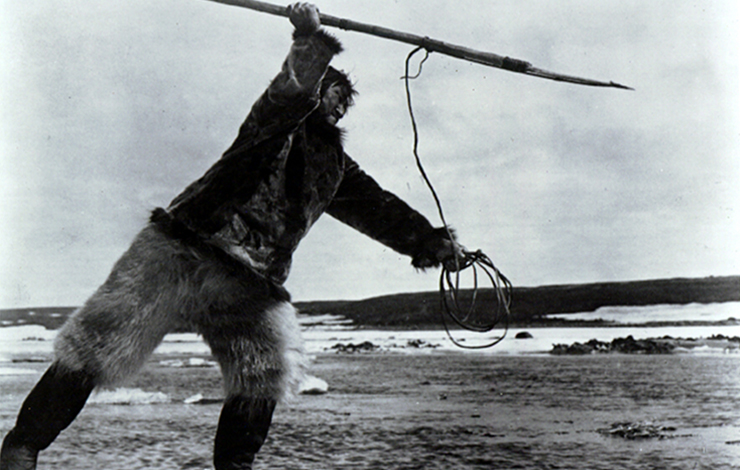 |
Expository documentaries are prominent in today’s documentary culture, but began alongside the poetic documentary in the 1920s as an alternative to the often experimental films that were being produced. Expository documentary looks at an argument and then walks the audience through that argument, providing evidence to support the claims and reasoning. Similarly, Expository films can introduce an audience to a point of view, and explain to them the reason behind that point of view, as nature based expository films often do. These films are typically narrated, providing information about what you are seeing unfold on the screen. The film that is considered often as the first feature-length documentary, "Nanook of the North" (1922) falls into the category of an expository film. Nanook of the North used footage that the filmmaker Robert Flaherty had shot, and then a voice over recorded later to tell the story. This typically is used to create documentaries on historical subjects, as it allows archived footage and photographs to be shown and explained. Nature documentaries by companies such as the BBC, and National Geographic heavily rely on this style, as they can collect footage and then create a story with it after the fact.[6]
Reflexive Documentary
Awareness of the process
If the historical world provides the meeting place for the processes of negotiation
between filmmaker and subject in the participatory mode, the
processes of negotiation between filmmaker and viewer become the focus
of attention for the reflexive mode. Rather than following the filmmaker in
her engagement with other social actors, we now attend to the filmmaker’s
engagement with us, speaking not only about the historical world but about
the problems and issues of representing it as well. we now attend to how we represent the historical world
as well as to what gets represented. Instead of seeing through documentaries
to the world beyond them, reflexive documentaries ask us to see documentary
for what it is: a construct or representation. Just as the observational mode of documentary depends on the filmmaker’s
apparent absence from or non-intervention in the events recorded,
the documentary in general depends on the viewer’s neglect of his or her
actual situation, in front of a movie screen, interpreting a film, in favor of
imaginary access to the events shown on the screen as if it is only these
events that require interpretation, not the film. The motto that a documentary
film is only as good as its content is compelling is what the reflexive
mode of documentary calls into question. [7]
 Surname Viet Given Name Nam (Trinh T. Minh-ha, 1989) |
Reflexive documentaries also address issues of realism. This is a style that seems to provide unproblematic access to the world; it takes form as physical, psychological, and emotional realism through techniques of evidentiary or continuity editing, character development, and narrative structure.Reflexive documentaries challenge these techniques and conventions. The reflexive mode is the most self-conscious and self-questioning mode of representation. Realist access to the world, the ability to provide persuasive evidence, the possibility of indisputable proof, the solemn, indexical bond between an indexical image and what it represents—all these notions come under suspicion.
Examples
- Reassemblage (Trinh Minh-ha,1982)
- Letter to Jane (Jean-Luc Godard and Jean-Pierre Gorin, 1972)
- Surname Viet Given Name Nam (1989)
Observational (Cinéma Vérité)
Fly on the Wall
In Observational documentaries the filmmaker is a neutral observer, it watches from the outside looking in. As the name suggests, they involve no intervention, no commentary and no re-enactment, and in essence try to observe the action as it happens and unfolds. It emphasizes a direct engagement with the everyday life of subjects as observed by an unobtrusive camera. Although many films may have observational sequences in them, wholly observational films have a distinct aesthetic, often preferring to use small crews (often a single director) and handheld cameras.
Origin
Observational observational documentaries have their history in the Direct Cinema and cinéma vérité movements of the 1960s.
Examples
- High School (1968)
- Salesman (1969)
- Titicut Follies (Frederick Wiseman, 1967)
- Primary (1960)
- the Netsilik Eskimo series(1967–68)
- Soldier Girls (1980)
- Oasis
Participatory
Participatory Mode: emphasizes the interaction between filmmaker and subject. Filming takes place by means of interviews or other forms of even more direct involvement. Often coupled with archival footage to examinehistorical issues.
Coming to bloom in the 60s and 70s shortly after Observational documentaries, participatory functions opposite to that idea. In this, the filmmaker interacts with and is a part of the story at times, often through interviewing subjects. This shift from the passive camera is described by Dr. Patricia Aufderheide as ‘somewhere in between an essay, reportage, and a well told tale’.[8] Participatory films not only tell a story to the audience, but they tell the filmmakers experience as well. This method rose to popularity alongside the invention of synced sound recording with video, and allowed for filmmakers to record direct interactions, eliminating the need for voice overs after the fact. The filmmaker’s role also shifts away from just recording to now directing, interviewing and guiding the story along.[9] The most famous example of this would be the famed The Thin Blue Line (1988), created by American filmmaker Errol Morris. In European film history, one of the first examples of participatory documentary is Chronique d’un été (1961). The french film translating to Chronicle of a Summer, was created with a British professor, French filmmaker and Canadian director. This team of creators open the film discussing their reasoning behind its creation, and then go on to to interview individuals about society and happiness. The film is recognized today for its innovative structure and unique approach to a documentary.[10]
Examples
- Chronicle of a Summer (1960),
- Solovky Power(1988)
- Shoah (1985)
- The Sorrow and the Pity (1970)
- Kurt and Courtney(1998)
Creating a Documentary
When starting with an idea about a documentary there are a lot of moving pieces that need to be addressed, and may different ways that directors and producers go about it. The New York Film Academy and the British Film Institute Academy have a lot of resources dedicated to laying down a foundation for new filmmakers to follow and ensure that they have covered the right grounds in this process. The subject and scope of documentaries can vary, which means that depending on the scale of the production, a lot more time and energy need to go into crafting these. Funding is an example of a step that we will be skipping over, as it has the most variation based on size of the production, and can be drastically different from film to film. Below are the outlined basic tasks that apply to creating any documentary, from a large budget production to a small student-led project.[11]
Pitch
Before writing a script and planning, it is essential that you have a short pitch that details exactly what you are setting out to create. The pitch will contain a few things:
- Title
- Logline - One or two sentence hook.
- Synopsis - A paragraph (or more) describing the project
- Locations - A few sentences about where the project will take place.
- Title
The pitch for large studio based projects usually is under 5 pages, while smaller projects will have a pitch of just a few sentences to ensure that all parties involved have an understanding of what could be created.[12]
Blueprint
At the Blueprint stage, you will be organizing and planning what material you will need to cover in order to tell your story to an inevitable audience. At this point, the blueprint is usually an outline that covers topics and themes, without going into technical details. The purpose of the Blueprint is to help breakdown the project into sections that allow for creative ‘wiggle room’ but still keep the fundamental story in place.[13]
Filming
In documentary work, the filming and principal production will take place before a script, with filmmakers working off of the Blueprint documents. In the field, these documents will have guides of what types of material to capture, and questions to ask, but no concrete assigned shots or scripted guide. This is because the story is usually told as it unfolds, and having a concrete script would not allow for that to happen. This typically varies depending on the filmmakers approach.
Script and Creation
Following principal production, the film’s script is then created before the story is crafted. Once data, research and footage is collected, the filmmaker’s job is to now utilize what they have and create the story the are trying to tell. This process occurs because the material that has been gathered can often change the initial plan of the film, and lead to the discovery of a more interesting story or details that were not initially known at the time of the pitch. A script will often be broken down into three categories for documentary: visuals, sound, narration/story. The visuals are where the shots of the story are laid out, and the audio next to it will be to arrange sound effects and music. The narration/story section will list either the script for a voice over or interview, or the purpose behind the shots listed in visuals. The director is now tasked with opening a door for the audience, into the information they have learned, and make sure their message is perceived in the development of the film.[14]
Section 2: Deliverable
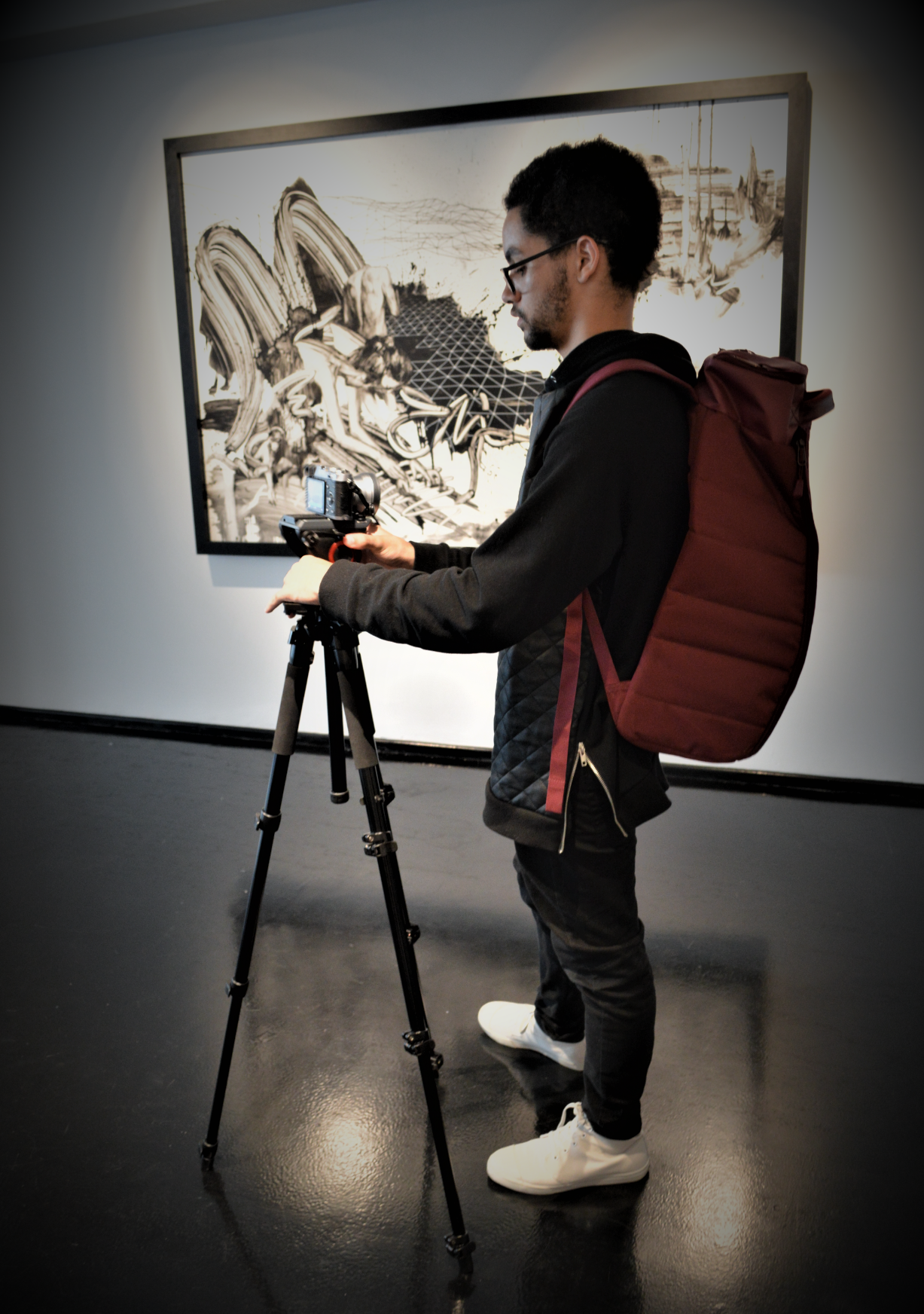 Unit London | |
| Location: | SOHO, London |
|---|---|
Pitch
For our own production, we chose to focus on showcasing recently created modern art This came from our own interest in the spaces, and the programs that they are doing to bring art on display and into the city around them. The 3 galleries we decided upon are the Serpentine Gallery & Pavilion, Unit London, and White Cube. Each of these galleries displays modern art with their own mission and purpose. We then decided that we would incorporate some of the different styles of documentary that we found into the different sections of our final film.
Modern Galleries: London
Logline
The city of London is full of new and old art, being showcased for visitors from all across the globe. This film takes a look at a few recent galleries, to show viewers what they do and why they are worth visiting.
Synopsis & Locations
Starting in London, we focus in on newer galleries that display modern and contemporary art. Our first gallery will be White Cube, which we will portray in the expository style. Unit London, the second gallery will be showcased in the poetic style. The third and final gallery before concluding our film will be Serpentine Gallery. In this segment we will use the participatory style to showcase the gallery and the Pavilion.
Blueprint/Script
Introduction
- Locations - High vantage point overlooking the city.
- The introduction will start with pointing out the different locations in the city, ending with the White Cube (our first stop). After this we will display titles and credits before a transition section of B-roll of the city to lead into the White Cube section.
White Cube
- Style - Expository. The White Cube section will include a narrated voice over going over the listed items below.
- Locations - White Cube Gallery external footage and internal footage
- History - Started in 2011 in a renovated space, serving as the main display for the White Cube organization. Contains 3 exhibit spaces and a theater and offices for educational programs and lectures.
- Purpose - The purpose of White Cube is to provide a space for artists to exhibit their work, and create innovative and unique shows.
- Current Displays - Currently exhibits at White Cube include Larry Bell's Smoke on the Bottom collection of freestanding large glass sculptures and unique reflective 'paintings' of aluminum layers and quartz burned on paper.
- Other Locations - White Cube also has exhibits on display at satellite locations in northern London, Hong Kong and Sao Paulo, Brazil.
- Transition - Exterior shots of the building leading back to the street.
Unit London
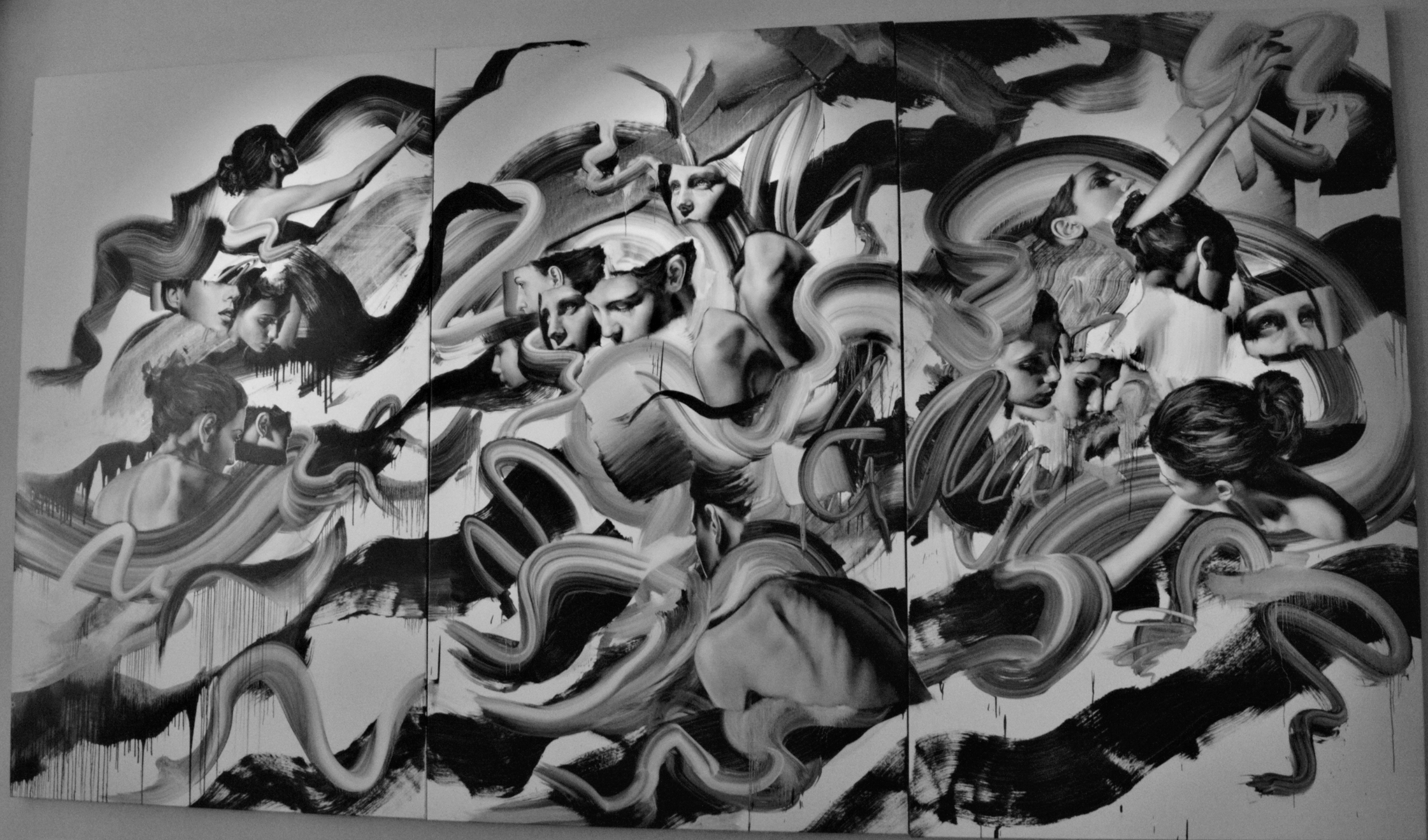 Gallery #2 | |
| location | SOHO, London |
|---|---|
- Style - Observational.
- Location - SOHO exterior and Unit London interior.
- Mission - To breakdown barriers of exclusivity and allow anyone to have access contemporary art.
- Current Exhibits - Tom French's Parallax and works by Cecile Plaisance
- Transition - Fade
Serpentine Gallery & Pavilion
|
Gallery #1 | |
| location | Hyde Park, London |
|---|---|
- Style - Poetic. Looking at the details and visuals in and around the gallery, providing the viewer a chance to discover new ideas.
- Location - Exterior and Interior of Serpentine Gallery. Hyde Park Exteriors. Exterior of Pavilion Construction.
- Purpose - The pavilion is an event that occurs every year, in which an acclaimed architect or designer is tasked with designing and building a structure in the pavilion space in 6 months time. Since 2000 the pavilion has led to the creation of innovative and inspiring designs.
- History - Slides with images of previous pavilions. Noteable ones include Zaha Hadid's, Bjarke Ingels' 2016.
- Current Displays - Illustrate construction on the 2017 pavilion and its artist.
- Transition - exterior shots of Hyde park and a traffic wipe-to-black.
Conclusion
- Location - London exterior shots, sunset.
- Summarize - Summarize project and how each gallery integrates art into the communities around them for residents and visitors of London.
Filming & Editing Notes
The video was filmed on the equipment that we had access to which includes a Fujifilm X100s (35mm f2), a Blackmagic Production Cinema Camera (40mm f2.8), a tripod and camera slider. We recorded audio that we needed with a Rode Microphone. The video was created in Adobe Premiere Pro and After Effects, and color graded in Da Vinci Resolve. Each segment is color graded in a different way, allowing the audience to distinguish the different styles.
Gallery
Conclusion & Final Video
This project covered the basic principles behind Documentary film making, and the different styles that have developed in the documentary world over time. We look at examples from around the world and British descent, and how they show the style that they are made in. The project also looks at the basic steps behind making a documentary, and illustrate that they can be applied to any sized production and adjusted to meet the needs of a particular project. We also successfully developed an introduction to several unique spots in London that are worth visiting, and showcase the unique characteristics about them. In further research, students could look into the history of the British Film Institute, as it is a vast and very important organization in the history of modern cinema as we know. A video production could be developed more specifically about one of the galleries, with interviews. A historical approach could be taken with the records in the BFI Library about some of the films mentioned in the examples. A more art based path could be involve a project on the art in the individual galleries.
Attribution of Work
For milestones completed collaboratively, add a section here detailing the division of labor and work completed as part of this milestone. All collaborators may link to this single milestone article instead of creating duplicate pages. This section is not necessary for milestones completed by a single individual.
External Links
Unit London
White Cube London
Serpentine Gallery Pavilion
BFI Reuben Library
Image Gallery
If appropriate, add an image gallery
References
- ↑ Aitken, I. (2006). Encyclopedia of the documentary film. New York: Routledge.
- ↑ (2014). "Chronology of Documentary History." California: UC Berkeley Media Resource Center.
- ↑ (2011). "Making History: Exhibition Guide, Section 1, Films: Defining Documentary" London, Tate Liverpool.
- ↑ Nichols, B. (2017). Introduction to documentary. Bloomington, IN: Indiana University Press.
- ↑ Nichols, B. (2017). Introduction to documentary. Bloomington, IN: Indiana University Press.
- ↑ Pick, A., & Narraway, G. (Eds.). (2013). Screening Nature: Cinema beyond the Human. Berghahn Books. Retrieved from http://www.jstor.org/stable/j.ctt9qczx4
- ↑ Nichols, B. (2017). Introduction to documentary. Bloomington, IN: Indiana University Press.
- ↑ Aufderheide, Patricia. "Public Intimacy: The Development of First-person Documentary." Afterimage, University of Minnesota. v25 n1
- ↑ Henderson, Julia. (2013) "Participatory and Reflexive Modes of Documentary Response and Theory." St. Edwards University. Vol. 4.
- ↑ (2008) "Chronicle of a Summer - 1961." London, British Film Institute.
- ↑ (2014) "How to Write a Documentary Script." NYC. New York Film Academy.
- ↑ (2011) "Documentary Process" London, BFI Reuben Library.
- ↑ Hugh Baddeley, W. (1996) "Technique of Documentary Film Production" London, Focal Press. p144.
- ↑ Ibid
